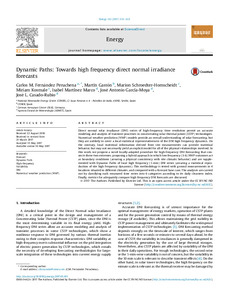Por favor, use este identificador para citar o enlazar este ítem:
http://hdl.handle.net/20.500.11765/7488
Dynamic Paths: towards high frequency direct normal irradiance forecasts
Registro completo de metadatos
| Campo DC | Valor | Lengua/Idioma |
|---|---|---|
| dc.contributor.author | Fernández-Peruchena, Carlos M. | es_ES |
| dc.contributor.author | Gastón, Martín | es_ES |
| dc.contributor.author | Schroedter-Homscheidt, Marion | es_ES |
| dc.contributor.author | Kosmale, Miriam | es_ES |
| dc.contributor.author | Martínez Marco, Isabel | es_ES |
| dc.contributor.author | García-Moya, José Antonio | es_ES |
| dc.contributor.author | Casado Rubio, José Luis | es_ES |
| dc.date.accessioned | 2017-08-18T07:17:01Z | - |
| dc.date.available | 2017-08-18T07:17:01Z | - |
| dc.date.issued | 2017 | - |
| dc.identifier.citation | Energy. 2017, 132, p. 315-323 | es_ES |
| dc.identifier.issn | 0360-5442 | - |
| dc.identifier.uri | http://hdl.handle.net/20.500.11765/7488 | - |
| dc.description.abstract | Direct normal solar irradiance (DNI) series of high-frequency time resolution permit an accurate modeling and analysis of transient processes in concentrating solar thermal power (CSTP) technologies. Numerical weather prediction (NWP) models provide an overall understanding of solar forecasting, but they are unlikely to cover a local statistical representativeness of the DNI high frequency dynamics. On the contrary, local statistical information derived from site measurements can provide statistical behavior, but may not necessarily yield an explicit model for all of the physical relationships involved. In this work, we propose a novel locally-adapted procedure for high-frequency DNI forecasting that connects these two extremes, proposing a hybrid approach in which low frequency (3-h) NWP outcomes act as boundary conditions (assuring a physical consistency with site climatic behavior) and are supplemented with Dynamic Paths of local high frequency (1-min) DNI series (assuring a statistical reproduction of site high frequency dynamics). This methodology is tested with ground measurements in 4 locations situated in different climates, and compared with a forecast base case. The analyses are carried out by classifying each measured time series into 6 categories according to its daily clearness index. Finally, metrics for adequately compare high frequency DNI forecasts are discussed. | es_ES |
| dc.description.sponsorship | This project has received funding from the European Union’s Horizon 2020 research and innovation programme in the Pre- FlexMS project under grant agreement No 654984. | es_ES |
| dc.language.iso | eng | es_ES |
| dc.publisher | Elsevier | es_ES |
| dc.rights | Licencia CC: Reconocimiento CC BY | es_ES |
| dc.subject | Forecast | es_ES |
| dc.subject | Dynamic Path | es_ES |
| dc.subject | Variability | es_ES |
| dc.subject | Direct Normal solar Irradiance (DNI) | es_ES |
| dc.subject | Numerical weather prediction | es_ES |
| dc.title | Dynamic Paths: towards high frequency direct normal irradiance forecasts | es_ES |
| dc.type | info:eu-repo/semantics/article | es_ES |
| dc.relation.publisherversion | https://dx.doi.org/10.1016/j.energy.2017.05.101 | es_ES |
| dc.rights.accessRights | info:eu-repo/semantics/openAccess | es_ES |
| dc.relation.projectID | info:eu-repo/grantAgreement/EC/H2020/654984 | es_ES |
| Colecciones: | Artículos científicos 2015-2018 | |
Ficheros en este ítem:
| Fichero | Descripción | Tamaño | Formato | ||
|---|---|---|---|---|---|
| energy_132_2017.pdf | 1,36 MB | Adobe PDF |  Visualizar/Abrir |
Los ítems de Arcimis están protegidos por una Licencia Creative Commons, salvo que se indique lo contrario.





